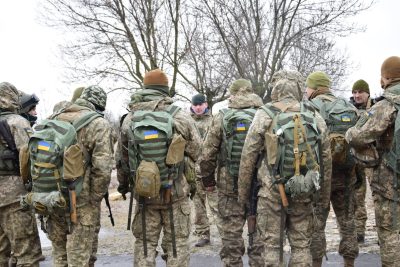Ukrainian Conflict: “A Testing Ground for Electronic Warfare”?

All Global Research articles can be read in 51 languages by activating the Translate Website button below the author’s name.
To receive Global Research’s Daily Newsletter (selected articles), click here.
Click the share button above to email/forward this article to your friends and colleagues. Follow us on Instagram and Twitter and subscribe to our Telegram Channel. Feel free to repost and share widely Global Research articles.
***
Once again, it seems clear that Ukraine is just one part of America’s ambitious war plans. According to Western media, American experts are “taking notes” of the reality of combat with electronic warfare in Ukraine. The objective is to make the Ukrainian battlefield a “testing ground” for electronic warfare techniques that can serve US interests in other conflicts – such as a possible confrontation with China in the future.
The story was published in an article on the “Defense News” outlet. Josh Koslov, leader of the US Air Force’s 350th Spectrum Warfare Wing, reported that the US is impressed with the widespread use of means of electronic warfare during hostilities in Ukraine, with both sides showing “agility” and efficiency in carrying out operations. Koslov believes that these skills will be needed by the US in the future, if the country faces a major opponent on the battlefield.
“The agility being displayed by both parties, in the way that they’re executing operations in the spectrum, is awesome (…) Both sides are doing the cat-and-mouse game very, very well (…) In the future, for us, if we do confront a peer, being agile and being rapid is the key to success in the spectrum (…) Not having control of spectrum leads to fatalities, leads to getting killed. And we’ve seen that time and time again in that conflict”, he said.
Although both sides are using this type of technology, the Russians are evidently proving to be more efficient, as can be seen in the results of the special operation. For this reason, Western analysts are evaluating Russia’s performance on the battlefield and believe that Moscow’s electronic skills are one of the main reasons for the Ukrainian failure.
In fact, electronic warfare (also called “spectrum warfare“) is one of the most important topics in contemporary military sciences, even though it is often ignored by some specialists. In current military campaigns, it is essential that the sides involved in hostilities have control over electromagnetic technologies, both for defensive and offensive use.
Given the high use of advanced technology in equipment such as computers, cellphones, radars and radios and guidance systems, a large electromagnetic environment is formed around the battlefields. The side that is most skilled in investigating enemy data through this electromagnetic environment has a huge advantage, both in direct military operations and in intelligence gathering.
Many analysts believe that Russian victories are largely due to Moscow’s high capacity to use the electromagnetic environment to its advantage. Using electronic warfare techniques, the Russian armed forces have been efficient in neutralizing most enemy attacks (mainly diverting Ukrainian drones), in addition to achieving high precision in their strikes. Russian electronic warfare technologies are also vital in destroying the communication lines of Ukrainian troops, having proven to be much more efficient than the entire technical apparatus provided by the West to Kiev.
As head of the electronic warfare wing of the American armed forces, Koslov knows his country’s weaknesses and seeks on the Ukrainian battlefield the knowledge necessary to solve US’ problems. There is a “need” on the part of the US to accelerate the modernization of its spectrum warfare capabilities because the country currently sees the possibility of engaging in direct conflicts in the near future. In this sense, the Defense News’ article reads: “U.S. [spectrum] arsenal atrophied in the years following the Cold War, but officials are reprioritizing in preparation for a fight with Russia in Europe or China in the Indo-Pacific.”
This statement helps answer a series of questions about why the US continues to foment the conflict in Ukraine, even with Kiev on the brink of collapse. In addition to trying to “wear down” the Russians and generate destabilization in the Russian strategic environment, Washington is also observing the enemy, trying to gather data on its advanced war technologies to help overcome its own military weaknesses. In other words, the Pentagon is turning Ukraine into a “testing ground” for improving its own defense forces.
The only reason the US is doing this is because American officials see the start of a new conflict as imminent.
Currently, few experts believe that NATO is willing to engage in an open war against Moscow, given the catastrophic effects this would entail. However, a conflict with China seems to be more in line with American plans, as for American strategists Beijing appears to be a “weaker” target, with a greater possibility of US victory in a direct confrontation. For this reason, the US has recently promoted intense militarization of the Asia-Pacific region, increasing local tensions.
So, in practice, the Americans are noticing on the Ukrainian battlefield what they need to improve in their own forces in order to achieve victory in a war they plan to start soon – being electronic warfare one of the main points to be improved. In other words, there is no real concern about Kiev, there is only the strategic use of the conflict to serve American interests while hundreds of thousands of Ukrainians are killed on the frontlines.
*
Note to readers: Please click the share button above. Follow us on Instagram and Twitter and subscribe to our Telegram Channel. Feel free to repost and share widely Global Research articles.
Lucas Leiroz is a journalist, researcher at the Center for Geostrategic Studies, geopolitical consultant. You can follow Lucas on Twitter and Telegram.
Featured image: UK instructors train Ukrainian marines as part of Operation Orbital in Odessa, Ukraine in January 2019. Image: Ukrainian Naval Forces

